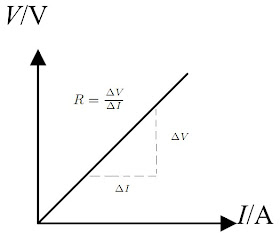Explain Ohm S Law Graphically

Thus ohm s law can be verified using following circuit diagram.
Explain ohm s law graphically. Where i is the current through the conductor in units of amperes v is the voltage measured across the conductor in. Hence in the graph of v against i given above the slope of the graph is the resistance. Or another funny way to explain ohm s law. We need two points from the graph to find the slope.
If the apply voltage across a circuit is 50v and a series connected resistor in the circuit which resistance is 10. Ohm s law states that under constant temperature the current passing through conductor is directly proportional to potential difference applied across it. Load analogy to understand the ohm s law. To help remember the formula it is possible to use a triangle with one side horizontal and the peak at the top like a pyramid.
Click image to enlarge. C v i graph how to use ohm s law formula to solve numerical problems. The statement implies that the ratio of voltage and current is constant and is called resistance. Ohm s law states that the voltage or potential difference between two points is directly proportional to the current or electricity passing through the resistance and directly proportional to the resistance of the circuit the formula for ohm s law is v ir this relationship between current voltage and relationship was discovered by german scientist georg simon ohm.
Resistance is measured in ohms. In the top corner of the ohms law triangle is the letter v in the left hand corner the letter i and in the right hand bottom corner r. Shristisingh2401 shristisingh2401 ohm s law states that the potential difference across the ends of a given metallic wire in a electric circuit is directly proportional to the current flowing through it provided it s temperature remains constant. This shows that the current is proportional to the potential difference.
Ohm s law states that the current through a conductor between two points is directly proportional to the voltage across the two points. This is sometimes known as the ohm s law triangle. Introducing the constant of proportionality the resistance one arrives at the usual mathematical equation that describes this relationship. Ohm s law state that the current is directly proportional to the voltage across the conductor or resistor.
Ohm s law states that the voltage across a conductor is directly proportional to the current flowing through it provided all physical conditions and temperature remain constant. If we plot a graph of the current i against the potential difference v it will be a straight line figure c.
















